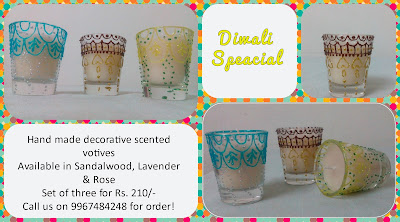Initially when I started making candles I
faced some candle making problems. Many a times I found the solutions
accidentally and just around the house. Getting that perfect candle requires
lots of trials and errors and every candle maker has their own formula and
ways. Here are few tips to troubleshoot some common candle making problems:
1.
Wax leakage from the wick hole
-
·
Many times even the sealer available
in the market has failed to hold in the wax. One day when I was out of the
sealer I tried the leftover wheat flour dough from my kitchen. And since then
it has never failed in my experience. Apply just a little dough around the wick
hole and you are set for leakage free candle making.
·
Other method which I find very
neat and clean is using a magnet. However, this is useful for metal molds
only. Fit the candlewick in the candle stand and place it on the wick hole
inside the mold. And from the bottom of the mold place the magnet.
2.
De molding candle - Often
removing candle from the mold can be a challenge. Here are few tips you may
try,
·
Make sure that the candle is
completely dry.
·
If your candle is dry and still
not coming out easily, place it in the freezer till the mold is cold to touch
for about 5 minutes. Make sure you don’t keep the mold any longer, this may
cause your candle to crack.
·
Mold release spray on the
inside of the mold will help remove the candle easily. Vegetable oil also acts
as an excellent mold release agent. Just a few drops enough to cover the mold
walls, any more than that will cause mottling effect which you may not desire
in your candle.
3.
Mold maintenance – here are
few tips to ensure your molds live long:
·
Make sure you never clean your
molds with water. It will only rust the metal mold.
·
After you are done making
candles, spray a little mold release spray or vegetable oil from inside and
from outside of the metal mold. This will help in cleaning the left over wax,
if any and not cause rust.
·
Store your molds well in a
carton to prevent any bends.
Hope these helped.






